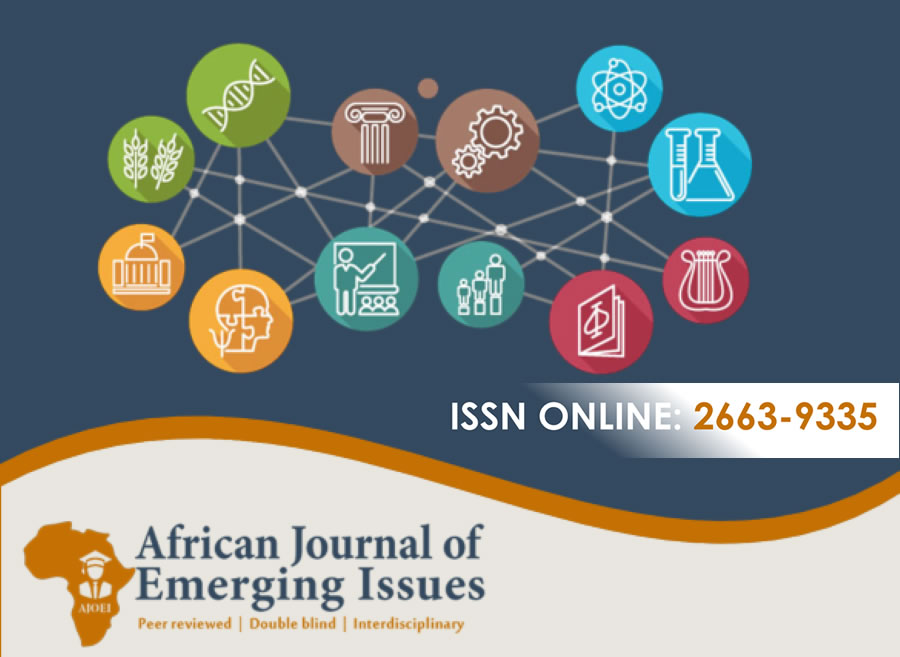TECHNICAL EFFICIENCY OF RAILWAY TRANSPORT SYSTEM IN KENYA: A CASE OF THE STANDARD GAUGE RAILWAY TRANSPORT SYSTEM
Abstract
Purpose of the Study: The study's purpose was to investigate the level of technical efficiency of Kenya's standard gauge railway goods transport system from Fiscal Year 2018/19 to Fiscal Year 2023/2024.
Problem of Statement: According to Kenya Railways' Strategic Plan 2023-2027, the Corporation has been unable to maximize the value of its assets while also meeting increasing market demand. This is a clear indication that the SGR freight transport system must be efficient to meet the growing market's high demand.
Methodology: To achieve the study's objectives, a non-experimental research design was used. Stochastic Frontier Analysis was used to estimate the gauge's technical efficiency levels. The Stochastic Frontier Analysis results were then subjected to regression analysis using the Tobit model to identify the factors influencing the technical efficiency of Kenya's standard gauge railway transport system.
Results: The study found that the average technical efficiency levels for the Net Tonne Kilometre model were 0.94 (94%), while the revenue model was 0.873 (87.3%). The technical efficiency levels for the Net Tonne Kilometre model showed that the railway system is extremely effective at managing goods transportation, with only minor inefficiencies limiting its potential. However, the slightly lower average technical efficiency levels for the revenue model highlight a problem in translating operational success into financial performance. The inclusion of macroeconomic variables such as inflation and exchange rates in the models revealed more nuanced effects, with inflation having a negative impact on efficiency and exchange rates having a mildly positive effect.
Conclusion and Policy Recommendations: The study concluded that, while Standard Gauge Railway freight services have high technical efficiency in freight handling (94%), there is a significant gap in financial performance, with revenue efficiency of 87%. To address this, disconnect, policymakers were encouraged to adopt improved pricing strategies, cost management, and adaptability to macroeconomic factors, which are critical for maximizing the SGR's transformative role in Kenya's socioeconomic development and regional integration goals.
Keywords: Technical Efficiency, Railway Transport System, Standard Gauge Railway Transport System, Stochastic Frontier Analysis
References
African Development Bank Group. (2020). Ethiopia-Sudan - Feasibility Study on the proposed Standard Gauge Railway (SGR) connecting The Federal Democratic Republic of Ethiopia and The Sudan.
African Union. (2023). Programme for Infrastructure Development in Africa (PIDA): First 10-Year Implementation Report. file:///C:/Users/Administrator/Downloads/PIDA%20Progress%20Report_WEB.pdf
Aigner, D., Lovell C.A., and Schmidt P., (1977). Formulation and estimation of stochastic frontier production function models. Journal of econometrics 6: 21- 27. https://doi.org/10.1016/0304-4076(77)90052-5
Ali, A. I., & Seiford, L. M. (1993). Computational accuracy and infinitesimals in data envelopment analysis. Information Systems and Operational Research, 31(4), 290-297. https://doi.org/10.1080/03155986.1993.11732232
Archetti, C., Peirano, L., & Speranza, M. G. (2022). Optimization in multimodal freight transportation problems: A Survey. European Journal of Operational Research, 299(1), 1-20. https://doi.org/10.1016/j.ejor.2021.07.031
Bayane, B. M., Yanjun, Q., & Bekhzad, Y. (2020). A review and analysis of railway transportation system in the economic community of West African States: Towards the development of sustainable regional goal. Global Journal of Engineering and Technology Advances, 2(2), 11–22. https://doi.org/10.30574/gjeta.2020.2.2.0004
Bešinović, N. (2020). Resilience in railway transport systems: a literature review and research agenda. Transport Reviews, 40(4), 457-478. https://doi.org/10.1080/01441647.2020.1728419
Bijman, J., Mugwagwa, I., & Trienekens, J. (2020). Typology of contract farming arrangements: a transaction cost perspective. Agrekon, 59(2), 169-187. https://doi.org/10.1080/03031853.2020.1731561
Bouraima, M. B., Alimo, P. K., Agyeman, S., Sumo, P. D., Lartey-Young, G., Ehebrecht, D., & Qiu, Y. (2023). Africa's railway renaissance and sustainability: Current knowledge, challenges, and prospects. Journal of Transport Geography, 106, 103487. https://doi.org/10.1016/j.jtrangeo.2022.103487
Brautigam, D., Bhalaki, V., Deron, L., & Wang, Y. (2022). How Africa Borrows From China: And Why Mombasa Port is Not Collateral for Kenya's Standard Gauge Railway (No. 2022/52). Working Paper.
Byiers, B., Medinilla, A., & Karaki, K. (2023). Navigating green economy and development objectives: The political economy of greening transport in East Africa. ECDPM Briefing Note 159 (Part 4). Maastricht: ECDPM.
Charnes, A., Cooper, W. W., & Rhodes, E. (1978). Measuring the efficiency of decision-making units. European journal of operational research, 2(6), 429-444. https://doi.org/10.1016/0377-2217(78)90138-8
Chege, S. M., Wang, D., Suntu, S. L., & Bishoge, O. K. (2019). Influence of technology transfer on performance and sustainability of standard gauge railway in developing countries. Technology in Society, 56, 79-92. https://doi.org/10.1016/j.techsoc.2018.09.007
Coelli, T. J., Prasada Rao, D. S., O’Donnell, C. J., and Battese, G. E. (2005), An Introduction to Efficiency and Productivity Analysis, 2nd Edition, New York :Springer.
Gachui, M. W. (2020). Effect of Rail Freight Transportation on Operational Performance of Logistics Firms in Kenya (Doctoral dissertation, University of Nairobi).
Ghiyasi, M., & Cook, W. D. (2021). Classifying dual role variables in DEA: The case of VRS. Journal of the Operational Research Society, 72(5), 1183-1190. https://doi.org/10.1080/01605682.2020.1790309
Ghoshal, S., & Moran, P. (1996). Bad for practice: A critique of the transaction cost theory. Academy of management Review, 21(1), 13-47.
Githaiga, N. M. (2021). The Successes and Challenges of Kenya‟ s Mombasa-Nairobi Standard Gauge Railway Transport Operations: A Special Reference to the Users.
Greve, H. R., & Argote, L. (2015). Behavioral theories of organization. International encyclopedia of the social & behavioral sciences, 481-486.
Haaskjold, H., Andersen, B., Lædre, O., & Aarseth, W. (2020). Factors affecting transaction costs and collaboration in projects. International Journal of Managing Projects in Business, 13(1), 197-230.
Irandu, E. M., & Owilla, H. H. (2020). The economic implications of belt and road initiative in the development of railway transport infrastructure in Africa: The case of the standard gauge railway in Kenya. The African Review, 47(2), 457-480.
Ishikawa, A. (2021). Why does production function take the Cobb–Douglas form?. In Statistical properties in firms’ large-scale data (pp. 113-135). Singapore: https://doi.org/10.1007/978-981-16-2297-7_9





